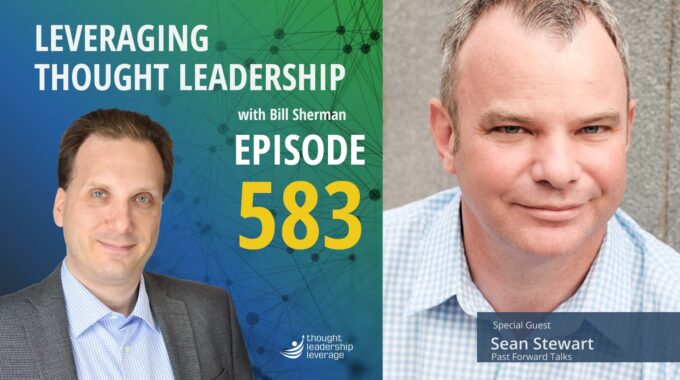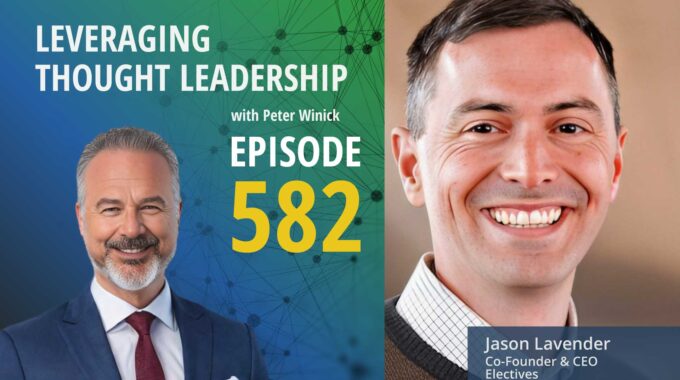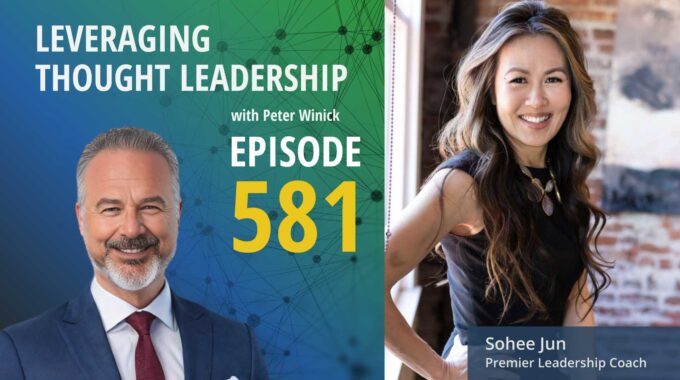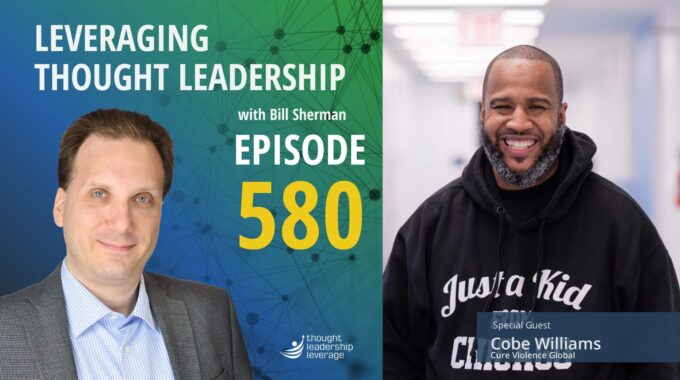Turning Everyday Objects into Tools for Effective Leadership A conversation with Sean Stewart on how…
Taking a Book to Scale | Nick Gray
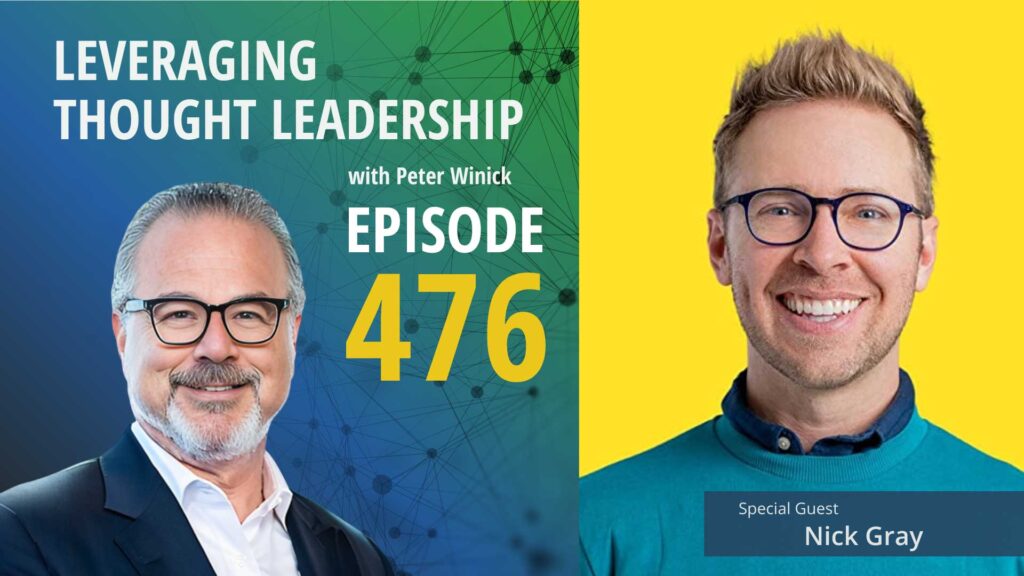
Creating diverse products from a book to reach scale.
An interview with Nick Gray about the steps required to take his book from the consumer market to the enterprise market.
It’s hard to create a successful strategy to take a book beyond the consumer market.
What can you do to ensure the success of your work?
Our guest today is Nick Gray, the Founder and Owner of Museum Hack and the author of The 2-Hour Cocktail Party: How to Build Big Relationships with Small Gatherings, which is the ultimate guide for hosting the perfect party to make friends and network.
While The 2-Hour Cocktail Party is full of excellent insights and has hundreds of 5-star reviews, Nick still struggles to get his book into the hands of those for whom it would have the most impact. Using Nick’s book as an example, Peter walks through the process of taking a book from shelf to scale.
Nick has seen real-estate agents and financial advisors have great success using the content of his book, together he and Peter dive deeper into those clients to develop a clear avatar, where to find them, and how to take the content to scale by approaching associations and parent companies to license the content on a large scale.
Another component to taking a book to scale is moving the contents to versatile offerings. Nick and Peter discuss how the book could become a series of videos, webinars, and training sessions that would allow great access to the material at a wide variety of price points.
If you’ve ever wondered what it is we do at thought leadership leverage this episode is like a sneak peek at the range of consulting services we offer and how we could help you take your material to the next level.
Three Key Takeaways:
- A good strategy covers: 1) Who do we best serve; 2) How are we going to serve them; and 3) What products, offerings, and solutions do they need?
- Knowing the audience that will get the most impact (and value) from your material is critical to a book’s success.
- If you are thinking about sharing your story, be sure to include real stories, human moments, and a personal touch to your experience and insights.
If you need a strategy to bring your thought leadership to market, Thought Leadership Leverage can assist you! Contact us for more information. In addition, we can help you implement marketing, research, and sales. Let us help you so you can devote yourself to what you do best.

Transcript
Peter Winick And welcome, welcome, welcome. This is Peter Winick. I’m the founder and CEO at Thought Leadership Leverage and you’re joining us on the podcast today, which is Leveraging Thought Leadership. Today my guest is Nick Gray. And I’m just going to give you a sort of a highlight reel for the bio that was sent to me. So he’s launched a new book called The Two Hour Cocktail Party. Most people also know him as the founder of the museum, which is a business he started because he hated museums, which is another story. He’s done a TED Talk. He’s been in the web space. Let’s see what else there He was in a comedy troupe and obviously produced a Bollywood music video. So without further ado, welcome aboard, Nick. How are you today?
Nick Grey I’m doing great. Thanks for having me. Hello.
Peter Winick Great show to roll back a little bit. You and I had a conversation probably about a month or so ago, and we were just chatting, seeing if you’d be a good fit for the podcast. Obviously, you are. And it was sort of evolving into this conversation around strategy for thought leaders, which is obviously something that I’m really passionate about. And then you called me after we have that conversation kind of again, and I was like, Yeah, that sounds good. So tell me, I don’t know, maybe what was it about that that was interesting to you were resonating with you most?
Nick Grey Okay, So I made this book. It’s called The Two Hour Cocktail Party. And I am very I’ve been focused for the last seven months on more of a B2C audience trying to get my Amazon sales, my Amazon reviews, trying to share people about my book and things like that. And I’ve had some success, but I haven’t been making money off of the book. I haven’t been thinking about bulk sales or the corporate sales or B2B stuff. And you just started asking me questions during the call that made me think in a completely different way. And you shared some resources of other people who are just absolutely crushing it, who didn’t have any of the number of reviews or social shares, the things that I had. And it just made me think, Oh my God, have I been working on all the wrong things for the last seven months?
Peter Winick So let’s stay there for a minute because you’re obviously a smart guy. This was your first book, so you do what you think you do, right? So you know what I somewhere between don’t like and despise on the B2C side of the world as a thought leader is, you know, number one unless you’ve got a preexisting list right unless you’re already a rock star. Continue to be a rock star. Great. But other than that, you have an unknown customer acquisition cost and you have an unknown lifetime value of a customer. And I think what happens is people look at indicators that they believe they will get from social media data that just don’t play right. So, Oh, but I have a million followers, but I have, you know, this many views on Instagram on Tik Tok or whatever. And there is a exponential difference between the level of commitment to say, I think this guy is Nick, so I’ll follow him versus I’ll spend 25 bucks, let alone on a book, let alone tens of thousands on offerings and services. So they would that’s a little bit. How is that is that where you’re thinking got jarred or change where I ruled your day?
Nick Grey Yeah. I think that I have seen people like atomic habits James clear sell 10 million copies and myself, you know, while I’ve sold seven or 8000 copies, it doesn’t feel like the book has broken out yet. And so I have spent a lot of time trying to get the book to break out ten, 15, 20,000 sales. And I’ve been sharing on social media, and I’ve been doing all these things. I think what was most interesting to me was what you were saying around corporate sales, around working, speaking in workshops, around bulk sales, around how to take my book and maybe turn it into a course. I think there’s work that you do that you were doing on the call, and I apologize. I didn’t write it down. That’s part of why I said, Well, let’s maybe do that call again so that other people can hear some of these ideas that you do as a part of clients for your sort of introductory call, and then they hire you for those more detailed strategy workshops. And that was my intent here, was to say, Hey, let’s just riff a little using my book as an actual example so others can hear and maybe get a new idea.
Peter Winick But yeah, so let’s do that. So, your book to our cocktail party, one of the things that I give you is feedback is actually read the book, right, which doesn’t always happen, right? Is it’s a really, you know, peak. Oh, like throw a cocktail party big deal like whatever. But it is a very good book because it is concise, it is clear, and you don’t leave anything to chance. So it is very even though you think it’s something like a cocktail party, lots of people don’t know how to do it Well, and this is really the ultra. But how to from how to invite people, the technology, how to prepare the apartment. Oh, and by the way, your apartment could be a crappy apartment in New York because most people in York, their apartment sucks. So, step one isn’t Buy a $5 million townhouse in Soho and impress your friends. So, it was a methodology. So, I said to you, This is really, really teachable. And I think there’s a lot more money to be made, an impact that can be had going to whatever Merrill Lynch and convincing them that they should put this out to every financial advisor that’s been on the job for years. So that’s kind of where I was thinking.
Nick Grey Yes, yes, especially. So I’ll give you one example. I know that my book of how to host events gets very rapidly adapted by people in real estate and in trying to know the power of client events. So I know, yes, I have that. But now what do I do with that knowledge? Okay, how would I even begin to get it to real estate? This is what I repackage it like. Is that what you do to help me come up with a sales sheet to say, okay, let’s go to real estate agents, people who have teams, let’s try to sell them. There’s a noodle of something that I have there, but I’m a smooth brained idiot. I don’t know what to do with that. I’ve just been laser focused on the book and it seems like that’s.
Peter Winick A great title for an autobiography that I might. I’m a smooth, brainy idiot. I think I’m or either that or like a punk band. I’m not sure which. Yes, it’s the smooth grain idiot. Sound like something would be playing downtown or something. So. So let me tell you what I think. So I think first and foremost, you got to have a strategy because you can’t tactically dabble in Maybe I’ll try this and maybe I’ll try this and maybe I’ll try that. The book is sort of your entree or the ticket or the price that you’ve paid to get into the club right now. What Now, one might argue that wait a minute, but everything’s in the book. Why would they pay me more money to deliver in a different format? But that’s kind of the whole point. When you look at some of the best business books that have ever been written, by whatever standard you choose, whether it’s commercial, whether it’s by reviews, whether it’s impact on people, there are derivatives of those works that exist in the book. But people want help. People want to consume that as a video-based training system. They might want to have some sort of kid, you know, hey, here’s all the things that you need to do. Here’s the cards, here’s how to run your first five parties. Right? So I think the question is, you’re not in the business of teaching people how to run a networking event. You’re teaching them how to use a networking event that’s low cost, that’s intimate, that’s personal in their home, probably for early-stage career folks to drive business and drive relationships. Right. So there might be two different use cases. Hey, you know, I just moved to, you know, whatever, Miami and I’d like to make some friends or I’m in a field that requires me, whether that’s financial services or real estate or whatever, to constantly build and maintain a network. And I’m early career, so I’m limited on resources and want to do that. I see that as sort of the two use cases, but you need the underlying strategy there and then you can figure out, well, who else has access to these folks or their associations. Maybe I should be speaking at, you know, I don’t know, whatever the there’s a million associations in real estate or mortgage brokers or anything along those lines. Should you be speaking there to be the evangelist of the brand? That would be a tactic that would fall under strategy.
Nick Grey Yes. So is that the type of work I mean, I want to make one small modification, which is to say that there are also many real estate and financial service professionals who are later on in their career. And it doesn’t require a lot of money, but they simply don’t have a repeatable format to host events, whether it’s to keep their existing clients, their mixes and matches. My book gives them that formula and that strategy, and it works. I see it in people that are in their forties and fifties that are like, Oh my God, this is perfect.
Peter Winick I need this sort of ministry. So now we’ve got now we’ve got three what I would call client avatars. So, one client Avatar is the young and hungry professional resource constraint, right? So, they’re using it because they can’t afford to take everyone to a fancy steakhouse and spend $1,000. Right? So that might be one piece. Second case might be someone that wants to for personal reasons. Right. You know, I’m doing a community. Yeah. You know, I just did throw a life changing event, a divorce, something like this later, sort of still that. And then you have, you know, as you just promoted a bit later in the career. So, it’s not a resource constraint, but I want to know the how to. So, I have the financial resources, but my events still suck. Yes. Yes. So, because there’s something about your work that is the right connection of connection, intimacy, curation. And then you don’t want the party to go on too long. Right.
Nick Grey Right, right. So, is that the work that you do when you work with authors like myself, that your strategy work is coming up with those avatars? Is your work in saying, okay, we have that one idea, let’s now package a product or let’s now build a list.
Peter Winick It’s all of the above. It’s all of the above in that a. Good strategy. A piece of the strategy is. Well, who are we going to serve? Right. And it’s usually the one answer to that that is always the wrong answer is, well, everybody could benefit. That’s the answer I hate the most, because unless you have the billion-dollar marketing budgets, probably more than that of Coca-Cola, you can’t afford to do that. So we need to get really specific. So notice that when I broke down the Avatars and I’m just doing this off the cuff now, that younger professional, I also put in a component into the avatar, the resource constraint. Right. So they want to do all these things, but they see people doing events where, you know, I can’t afford to spend $1,000 a ticket to take someone to the U.S. Open or the theater or whatever. How do I create that environment in my apartment or home versus someone in their fifties that might have the resources to do it? But you know what? There’s something refreshing and incredibly, there’s a vulnerability. To invite someone into your home is so different than to say, Hey, Nick, can we go grab dinner? I’d love to talk to you about something. It’s a totally different experience and people are relaxed and people like, Wow, Nick wants me in his phone. That’s like, that’s an honor. That’s something that that one would be respectful of.
Nick Grey Yeah, it really is. And it’s a part of my book about why it’s important to host at home that 95% of people should host at home. There’s very rare exceptions when you shouldn’t. But a lot of the objections of my home is too small to messy or too far away actually don’t really apply. And there’s ways to work through. But just like you said, here’s why to host at home because it turbochargers your relationship. It’s like going on a mini first date. It is a very vulnerable act to bring someone into your home and you build bigger relationships faster when you host it inside of your own home. It also takes you out of that mindset of a network. In a corporate, it’s much more generous to host at home, so I feel strongly about that.
Peter Winick Yup. Yup. If you’re enjoying this episode of Thought Leadership Leverage, please make sure to subscribe. If you’d like to help spread the word about our podcast, please leave a five-star review at ratethispodcast.com/ltl and share it with your friends. We’re available on Apple Podcasts and on all major listening apps as well as at Thought Leadership Leverage dot com forward slash podcasts.
Peter Winick So here to answer your question, you know a good strategy covers who are we going to serve, how are we going to serve them? And then what are the products, offerings and solutions, right? So you might have like let’s just give an example, there’s the book. Then there might be a video-based learning series with situational pieces, how to set up the home. And here’s a video on how to do this and do the cards and do the nametags and all this other sort of stuff. Then there might be a physical kit in a box. Hey, here’s a resource On how his eyes, maybe as a sales manager or real estate sales manager can teach others in the organization how to do this. Well, how can I evangelize your methodology? Hey, I’ve done this five times at home, so let me show you my colleagues how to do it, because I think you’d benefit as well. There might be situations where there’s a on the other end of the continuum, people that would pay you personally and you would need to be a premium product. Hey, coach me how to do this? I’m a CEO, I’ve got a fancy apartment, I’ve got a knee, I’ve got all that. But can you work with me one on one in a very bespoke, intimate way, Same knowledge, right? It’s just a matter of the, the delivery vehicle, the use case, and be commensurate. And that has to be commensurate with the pricing and the value.
Nick Grey Mm hmm. So is that what the work that you do? So you link up with authors and you say, look, you have this book. There are key lessons in here that are amazing, but some people want to learn in different ways. Let’s come up with the ideas of which video courses. So then one thing I would ask you is how do you think about pricing those courses or those video things? How do you how, how would I kind of yeah.
Peter Winick So that’s a great show. That’s a great question. So there’s everything’s a continuum. So one on the continuum, there’s a ton of stuff that’s free LinkedIn learning and all these other things. So one option might be and again, this is all going to be avatar dependent because of my young professionals in their twenties in real estate aren’t on LinkedIn. I would assume they are. And we need to think about TikTok. That might be a little bit different, but we might want to do sort of a freemium model where we take a sort of a teaser course, a ten-minute version of the course that we would give away on LinkedIn. But when I say give away, that might be free to 20 bucks or something like that, but it doesn’t give them the full robust piece. Maybe that’s an upsell, right? So here’s the fundamentals of or maybe you give me the equivalent of a chapter in the setup, but if they want the full piece, it’s further up there when it comes to the enterprise side of the house. And this is where it’s really interesting slash weird. It’s usually some sort of a sliding scale based on volume and usage. So you’d say like, Wow, okay, what if we went to Century 21? Or better yet, Realogy, the parent group of about seven different real estate companies like Coldwell Banker, Century 21 Better Homes and Gardner and said, You know what, you should pay me. And. Million bucks a year to license out this video-based program that I developed. It’s whatever, six modules of 7 minutes each or whatever it is, and push that out to your 2 million agents, because on a cost per agent basis, it’s pennies. And the impact that this can have if even 5% of them use this program, you know, they’re in a low volume, high ticket business. So each agent that went through your work sold one more unit of a house for 1 million home a year. It’s so no brainer for pennies like, you know, whatever. Now, if you’re in a low, very low margin, high volume ticket, maybe not, but things like real estate, things like financial services. Yeah, it’s all about customer acquisition cost and the average value of the transactions. You have to know your user case, you know who’s going to use it, what’s in it for them.
Nick Grey Do you then help your clients figure out a contact list or who to sell to, or do you just build the product and then they’re in charge of selling.
Peter Winick Any and all of the above. And in fact, Nic, 70, 80% of the work that we do is on the sales and marketing side of the house. Really our clients don’t come to. Yeah, because, you know, clients don’t come to us and say, I think I might have an idea. They come to us and say, I’ve got this thing. It’s a book or it’s something I’ve been doing for ten years. So they’ve got the idea now. The idea might need some doodling, it might need some validation or whatever, you know. But for the most part, the ideas are 80% there, or there’s more ideas than we could ever monetize. Right? They’ve written ten books, whatever. Where most need help is how do we get it out there consistently? How do we come up with the sales and marketing and distribution engine and a strategic partner side of the house so that I can go to the next thing? That’s a lot of fun because I hate sales and marketing, right? Right. That’s not why I did this. I did this to solve, you know, in in your case, your use case is fascinating because you did it to solve a problem. You had. You didn’t do this with some grandiose vision of I’m going to take over the world to be the world’s greatest networking guy. You’re like, Hey, I want to make some new friends. Great.
Nick Grey Right? Right. Yes, exactly. And then I found those benefits in building my own network in a different way. So that’s a good point. Yeah. Now, but I think now.
Peter Winick Is like the home. The home that you’re doing is the home that I get all the time because it’s not where your horsepower goes, Right? If I were to say to you, you know, Hey, Nick, I’m going to, I’m going to give you 60 days, right? I cleared up your calendar. Revenue is going to be saying, whatever. What are you going to do? You’re probably going to tell me right here, the book research another thing and that’s another piece of it not come up with some lead generation strategic partner distribution model because it’s just not. How are you?
Nick Grey Wire Right. I was thinking to my head, I’m like, Gosh, I wonder if, you know, if the goal was around revenue generation and selling bulk copies and things. Right now the name of the book is the two hour cocktail party. I wish I would have done like a two-hour networking event or something like that, that there’s a.
Peter Winick Benefit. I mean, it could be the two-hour brand or the two hour networking event, the two hour icebreaker, the two hour intimacy event, the two hour or whatever. Right. But but what I like about yours is it tells me. Exactly. And you and you’re very regimented in the book. It’s not 2 hours, but sometimes it’s three and a half. If you get in your place that doesn’t know, how do you start it, How do you curated it? How do you ended at like, I can see like based on reading the book at 2 minutes and 3 seconds. Yeah. Yes.
Nick Grey Yes, yes. Yeah. Which by the way, for those listeners, the number one tip I have for you, if you want people to show up on time, if you want to run a tight event, if you want people to come back to your events list both a start time and an end time for your event. Many people never list an end time for their events, and it makes it hard for people to commit to show up. And most people never show up actually on time. Then it creates what I call an extended awkward zone. When you listed starting at 6:00 and people say, Well, what time should I show up at seven or eight or nine? They never know.
Peter Winick Right? So when you say 6 to 8, I’m not going to do the standard New York. Well, six means I’ll be cool and show up at 715 because now I know I missed half of it. So it’s probably a little cool, relatively speaking, a joke at ten after you buffer that into the methodology and say, yeah, we at 6a1, you don’t ring the bell and say start but you know because you the other thing is you’ve done this again and again and again and again. I’ve worked out the case.
Nick Grey Yes. Hundreds of times. Hundreds of times.
Peter Winick Yeah. Cool. Well, this has been I want to just start to wind down a bit that what would you suggest or advise anyone? That’s where you are. Maybe two, three, four years ago, they got a thing that’s kind of becoming a thing, but they’re not really sure what to do with it. What might you advise those types of folks?
Nick Grey Best piece of advice that I have is start writing down your stories today. When I wrote my book, I was constantly trying to wrack my brain for the personal stories, the personal touches, the real-life moments and memories, people’s names, conversations, how it made me feel. There’s interesting anecdotes, and that’s what people. Will really want in a book. If you’re ever thinking about a book or a speaking tour or sharing your story. What people want are those personable moments. So my number one suggestion would be to start writing those down now, as small as they may feel today. You will wish that you had those in a couple of years.
Peter Winick No, I think that’s a great point, because if your book was just a methodology, it would kind of look like, you know, a script stage left and do this. But you humanize it with real life stories. Good, bad and ugly. There’s someone that broke a rule. Here’s someone here’s the benefit we got from following the rule that people feel silly or awkward about putting stickers on. So make sure you get the stickers that don’t rip half of someone’s cashmere sweater off and all that stuff. And I appreciate you coming on today. I appreciate your work and I appreciate you. Thank you so much.
Nick Grey Thanks for having me. More parties, everybody.
Peter Winick To learn more about Thought Leadership Leverage, please visit our website at ThoughtLeadershipLeverage.com to reach me directly. Feel free to email me at Peter at ThoughtLeadershipLeverage.com and please subscribe to Leveraging Thought Leadership on iTunes or your favorite podcast app to get your weekly episode automatically.


